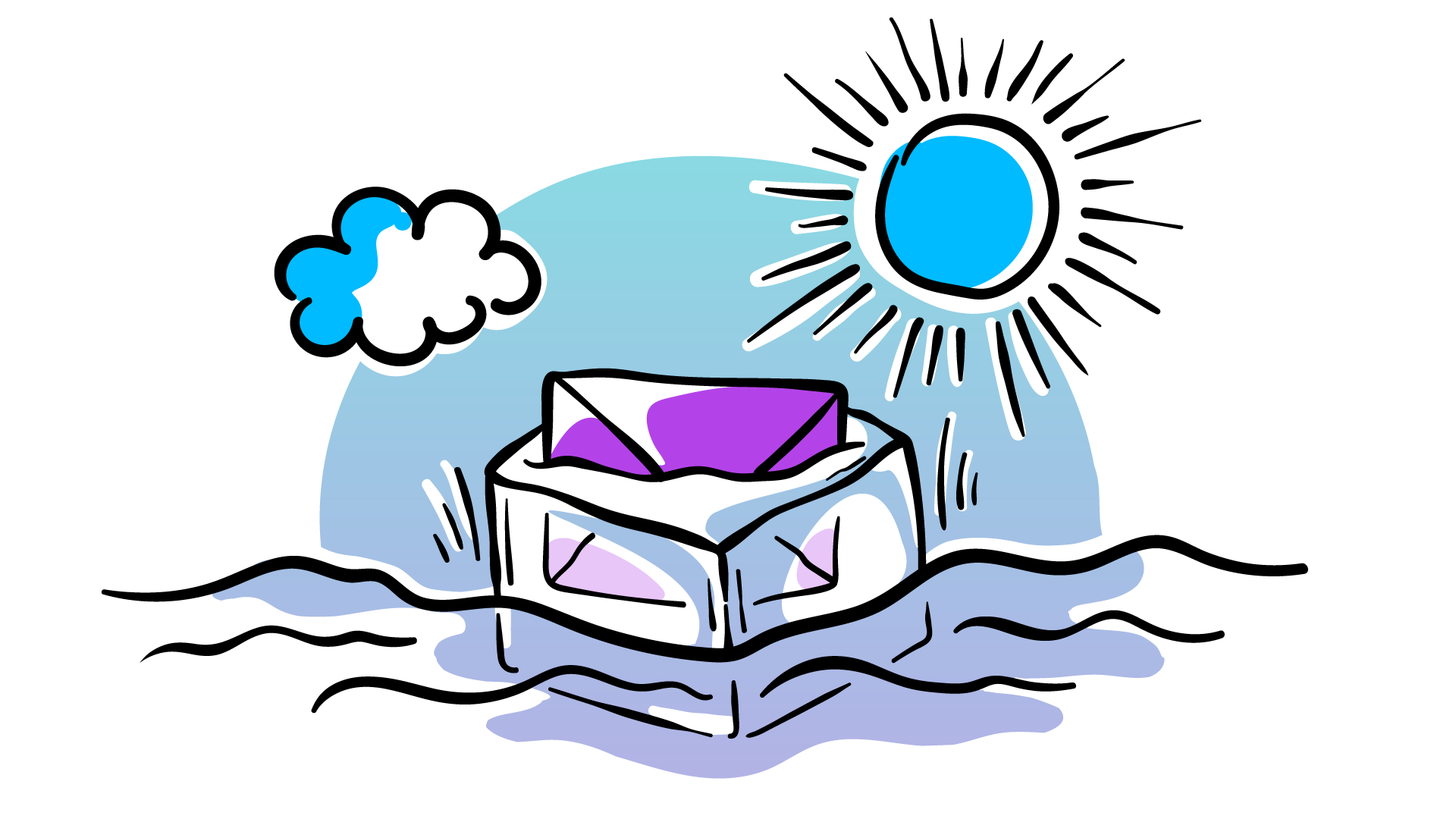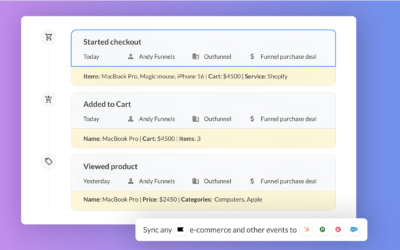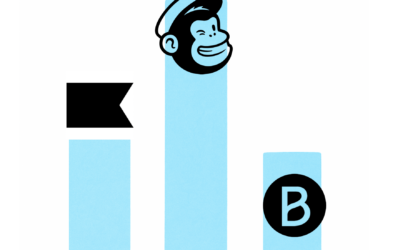Last updated: February 10, 2022
To say that I haven’t been the biggest fan of cold emailing would be an understatement. Like you, I receive so much spam that my attitude to this channel has been, well, cold.
Furthermore, I’ve mostly worked with companies where customer segments and price points dictate that outbound sales don’t make financial sense, so I’ve always prioritized inbound marketing. And it has worked, every time.
But in October 2020 I launched my first ever “proper” cold email sequence, and I’m really quite pleased with the results:
- 1139 people targeted, 2 emails sent to each
- 33-51% open rate (this compares to our monthly, opt-in newsletter)
- 3-6% engagement rate (replies and/or clicks)
- 10+ high-value demos
- 10+ new high-value partner newsletter subscribers
- 1 paying customer (although getting paying customers wasn’t the immediate goal)
So…
Does cold emailing work?
Yes, cold email outreach can work, if done well.
At this point, it’s worth mentioning that quite a bit of work went into sourcing and cleaning the list of prospects. In fact, I’m certain it would have been difficult to get these results without such preparation. But there were a number of smaller things at play as well. More on that below.
Context: what Outfunnel’s funnel looks like, and where does cold emailing fit in
Outfunnel is an automation tool that helps you automate sales-marketing workflows by connecting your CRM with your marketing tools.
Additionally, we offer a simple email campaigns tool for B2B use cases.
And we don’t charge a lot for the tool. This dictates that we’re inbound marketing heavy. Most of our efforts go into making Outfunnel easy to find, either via content, specific online searches, or one of our integration partners.
Enter our latest integration with HubSpot CRM. (Why build a marketing automation integration with a tool known for marketing automation? See here). We’d seen early interest from HubSpot users but we knew that it’d take ages for our inbound playbook to properly start to work across the HubSpot ecosystem.
We also knew that HubSpot had a strong partner ecosystem. This just begged the question: what if we sent them an email?
Here’s my cold email strategy, step by step.
Sending a cold email campaign: our process and tools
Step 1. Find a list of target companies
It’s relatively easy to find digital agencies that are also HubSpot partners. If you google “hubspot partner agency” or do a company search for “hubspot partner” on LinkedIn, you’ll easily get a list of companies. This process can be manual or automated, we used a simple scraper.
Step 2. Find a list of target people and their email addresses
I then used LinkedIn Sales Navigator ($99/month) to research the companies discovered in the previous step to identify the exact job titles to target. I landed on the following job titles: CEO, Managing Partner, Managing Director, VP, COO, co-founder, founder, owner, partner.
There are lots of tools that let you find people with specific job titles in target companies. We used Anymailfinder (starts at €29) for this. There are many other tools for finding email addresses, but Anymailfinder was recommended by someone that has tested various tools extensively.
We then had approximately 1300 contacts from relevant companies with a verified email address and another 1000 contacts with an unverified email address. Because a high bounce rate can drag down your email reputation, we only used verified email addresses.
As a sidenote, we’re now using Voila Norbert ($99/month) for finding the email addresses that Anymailfinder couldn’t find.
Step 3. Manually clean the email list
We then went through the list manually to weed out people whose job titles were close but didn’t match our target. We also tidied up the company name at that stage to make sure they can be used in the email as the merge field. This included removing any slogans or additions or the acronyms that indicate the type of legal entity.
This manual cleaning reduced the size of the email list by about 10%. The other way to look at this step would be: cleaning made the list 10% better.
The result: we had a list of 1139 people ready to be imported into our CRM.
Step 4. Craft effective emails
I broke the list into six chunks to be able to play with different copywriting. 5 of these were similar, 1 included a personalized image.
This basic email got the highest response rates and engagement (clicks and replies) — feel free to use it as a cold email template:
Email subject: Something new in the HubSpot ecosystem
Email body: Hi {{person.first_name}},
As a Hubspot {{organization.agency.tier}} you may find Outfunnel interesting. We’ve built a marketing automation tool that integrates with HubSpot ridiculously deeply, it’s available in the Hubspot Marketplace.
Why a marketing tool that integrates with Hubspot?
Free CRM from Hubspot + affordable email automation from Outfunnel = fantastic value. We’ve heard great things from companies who can’t afford a Professional plan right away.
Please note that we’ve been building deep integrations with CRMs for a while already. Our Pipedrive and Copper CRM integrations are very popular and HubSpot was the logical next step.
Just hit reply if you’d like me to send more info about our product and partner program, or if you’d like a 15-minute demo. Would love to work with {{organization.name}}.
Andrus Purde
Co-founder and CEO, Outfunnel
No longer interested? Unsubscribe
I was expecting two notably shorter versions of this email to perform better, but this rather long one delivered the best results. (Rather small sample size though.) Here’s the campaign report:

Step 5. Send the first cold email campaign
Unsurprisingly, we used Outfunnel (plans that include the email marketing Campaigns feature start at $49/month) to send the sales pitch.
It’s not really meant to be used as a cold email tool for a couple of technical reasons, the main one being that it uses Outfunnel’s servers and IPs rather than plugging into the email stack of customers. There’s also the fact that each email ends with an unsubscribe link that cannot be removed — this is something that some cold email senders want to avoid.
Sending emails was straightforward: after uploading contacts to our CRM (we use Pipedrive, segmenting with Person filters, but this would have worked equally well with Airtable, Copper or HubSpot) I added a tag to each of the six sub-segments, and I could then access the segments in Outfunnel. Too easy.
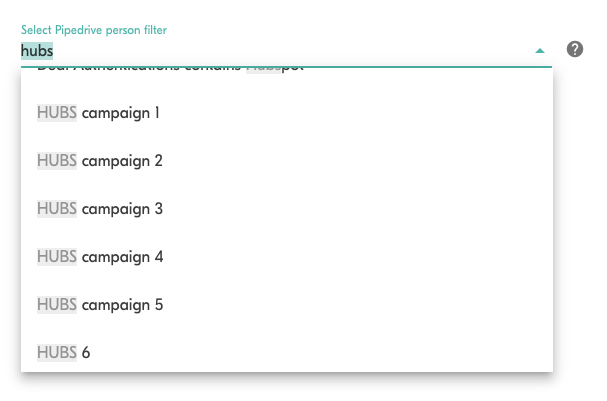
Step 6. Send follow-up email
About 10 days later I sent a follow-up email to everyone that hadn’t replied, booked a demo or clicked through to the site. I used Outfunnel’s native Lead scoring software to build a segment of contacts with a score lower than 4. We assign a value of 1 to email opens, 3 to email clicks and 10 to each page visit, so if someone had clicked through to the site, they were automatically excluded from the follow-up email.
27 people had a high lead score after the first email but hadn’t replied or booked a demo. I followed up with these leads with a more personal, hand-crafted email.
This I’d like to emphasize: I could have also sent a third and fourth email but I chose to stick to two. Yes, this potentially left some proverbial money on the proverbial table, but hey, none of these people had given me permission to email them.
The fact-based case for sending only two emails is that no one reported this campaign as spam (as I’m sure would have happened had I kept emailing). The gut feeling-based case is: it’s the right thing to do.
Here’s one of the follow up-email templates I used to email people with a low lead score:
Email subject: Re: Something new in the HubSpot ecosystem
Email body: Hi {{person.first_name}},
I sent you an email a few weeks ago about Outfunnel, a new app in the HubSpot ecosystem. As a Hubspot {{organization.agency.tier}} I thought you’d find it relevant.
It’s the most affordable way for HubSpot CRM users to do email automation
If that’s not relevant for you, you need to do nothing. I’ll never email you again.
But if a super affordable marketing automation tool is relevant for {{organization.name}} customers, just reply to this email. Happy to send you more about our partner program and/or do a 15-minute demo.
Andrus Purde
Co-founder and CEO, Outfunnel
No longer interested? Unsubscribe
This email was delivered to 922 people, and I received 13 replies. Not bad. Here’s the campaign report:

Step 7. Follow up and do the actual demos.
Nothing special in this step.
10 cold emailing lessons learned
I already mentioned the results above but I’d say that the 35-51% open rate, 3-6% engagement rate (replies and/or clicks) and 1% demo rate were rather good. And this success comes down to 10 things.
Without further ado, here are my cold email tips.
1. It pays to put effort into proper targeting and list building
We spent quite a bit of time defining the ideal recipient (“buyer persona”) and finding a workable way to collect (read: scrape) a list of contacts.
It would have been much more time-effective to just buy a list of ad agency leaders from one of the many contact vendors, but I’m certain we would have seen a poorer success rate.
2. Even when using the best tools, you still need to clean and sense check the data manually
We used AnyMailFinder which was recommended to us by someone who has used different tools extensively. We still needed to manually remove 10% of the contacts and edit the data, so using merge fields would make sense.
This made our target list 10% smaller better.
3. Send follow up sequences to prospects (but not too much)
We got more engagement and sales reps got more demos from the follow-up email, compared to the first one. So you’re missing out if you don’t follow up with your prospects.
Important caveat: don’t overdo it if you don’t have explicit permission to email. Otherwise, your unsolicited emails will end up in the spam folder.
4. The fewer call-to-actions in the email content, the better
I was certain that one of my conclusions would be that a shorter email performs better than a longer one, but data suggested otherwise.
What the test did confirm was that optimizing for one prominent CTA (eg. reply or click) and having a “fallback CTA” (eg. hyperlink somewhere in the email) leads to best results.
As a side-note: only two demos were scheduled directly from my Calendly link. The majority of demos resulted from them sending me their scheduling link or agreeing to a demo after getting some more information from me first. In the future, I’ll keep my Calendly link out of the first email.
5. Lead scoring helps decide who’s ready for a more personalized approach and who needs a reminder
Lead scoring was super useful for defining audiences for follow-ups. It gave me an easy way to exclude the warm leads (who had clicked through to the site and browsed multiple pages) from the cold leads.
The less engaged ones got a second generic email from me, sent from Outfunnel, and the ones with high lead scores got a personalized, hand-crafted follow-up.
(In hindsight, I should have personalized the high lead score follow-up even more by including details from their website or social profiles. One for next time.)
6. Web tracking provides useful context
A couple of the contacts replied with very specific asks. For example, one lead requested me to “Send info on your partner program, please.”
When you get a question like this from someone who’s new to your product, do you just honor their request, or do you also add some product details to help them understand the value proposition?
With website visitor tracking software, you’ll know. I was able to see that this particular lead had already seen our features page, so I knew I need not unnecessarily pitch my product.
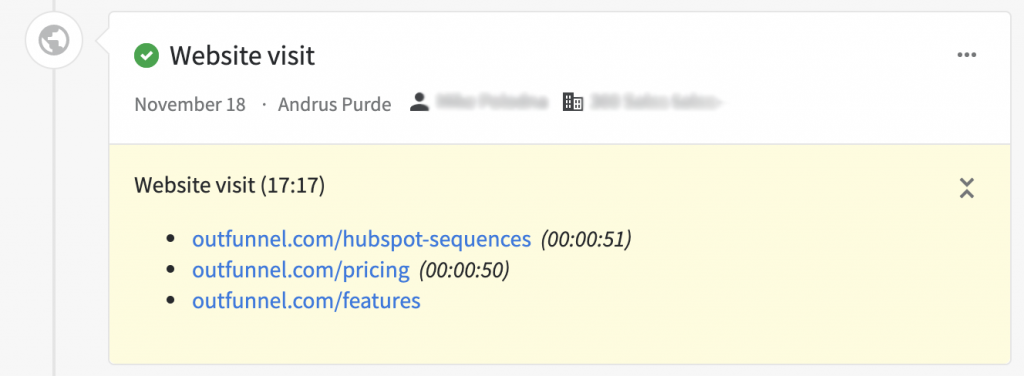
7. Image personalization needs some more practice
One of the variations of my cold emails included hyper-personalization. Here’s an example of how it looked, with the recipient’s website shown on my screen:
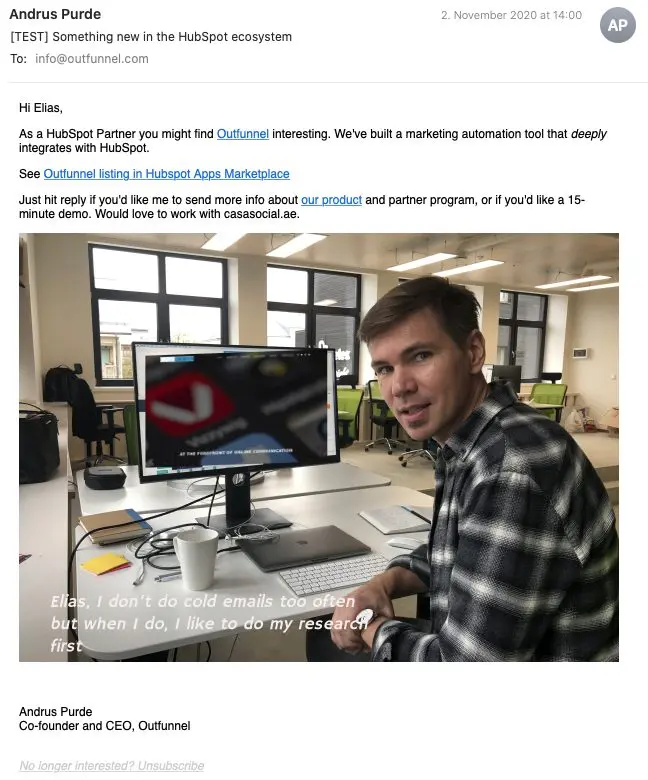
So, the website shown on my screen was customized for each recipient. That’s the magic sauce of Hyperise.
I was surprised to find that this variation of the email with a personalized image performed worse compared to text-based ones. After all, personalization is supposed to be a key to getting good results with email outreach, so I had high expectations for hyper-personalization.
I consulted with Hyperise founder Ian Naylor, and here’s what he advised me to do differently the next time:
I think the angle of the screen and the mismatch with the website makes it look a bit odd. I would suggest retaking with the screen more straight on, to work better from a composition perspective. (or even better, create as a GIF)
The white text at the bottom is lost, I almost didn’t notice it, I would make it bigger and also set an opposing colour shadow, to make the text pop more.
8. It’s good to have something “soft” to sell if you can’t get to a demo right away
I had dozens of briefer or longer email conversations, and some of the replies were “interesting but not right now”. Also, some people I spoke to on demos were interested but didn’t have suitable customers to recommend Outfunnel to right away.
I asked each of them whether I could add them to our partner mailing list and 100% of them said yes. This way there’s a natural way for us to educate leads about Outfunnel without violating privacy laws.
Note to self: make sure to write a damn good partner newsletter soon.
9. It’s good to have an unsubscribe link
With Outfunnel, all emails include an “unsubscribe” link that cannot be removed. So each of the emails we sent out as part of this campaign also sported this link in the footer.
This is great for the recipient because they can silence unwanted senders. It’s great for the sender because if there wasn’t an unsubscribe link, the recipients would simply mark the email as spam, and that can seriously damage your domain reputation and email deliverability.
I didn’t include an unsubscribe link to the 27 personalized emails I’d sent to warmer sales leads after the first campaign, and received this:
Andrus please take me off your mailing list. Also add the unsubscribe option below your email signature to all your cold emails and follow-ups. This will lessen your chances of being marked as Spam….
I would not have emailed this lead again, but after receiving this I even deleted her email address from our system.
10. Meta lesson: don’t discount something for the wrong reasons
I’d been against cold outreach email because there’s a lot of spam out there and I didn’t want to add to that.
But I was also anti-cold sales emails because it was a new if not alien thing for me. And it’s super easy to be anti new things (a fact well-illustrated by many recent political happenings).
Had this cold email strategy failed, that would have been a much better reason to be against the channel.
So my meta lesson is to write things off because of real experiences, not prejudices or “things you’ve heard from a source”.
Conclusion: cold emailing works, but only if executed well
Our first cold outreach campaign taught many good lessons and gave us a new powerful tool to add to our marketing arsenal.
But with great power comes you-know-what.
If and when we do cold pitches, I promise we’ll do our homework in targeting, clean lists thoroughly, include an unsubscribe link, and not email more than twice.
Shout out to all businesses that are already doing this, starting with Chartmogul. A great example of a “cold email pitch”, no?
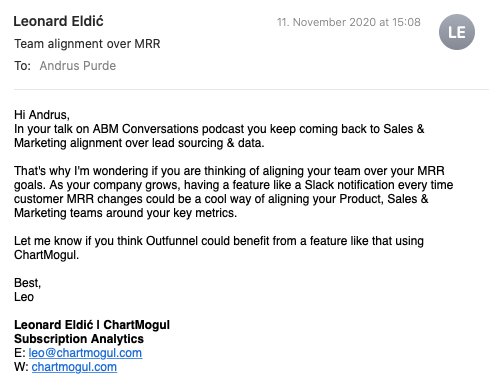
I hope you enjoyed learning my cold email formula. I would love to hear your comments, thoughts, and questions.
P.S. And if you happen to be a digital agency working with implementing sales and marketing tools, I’d love to tell you more about our partner program.

